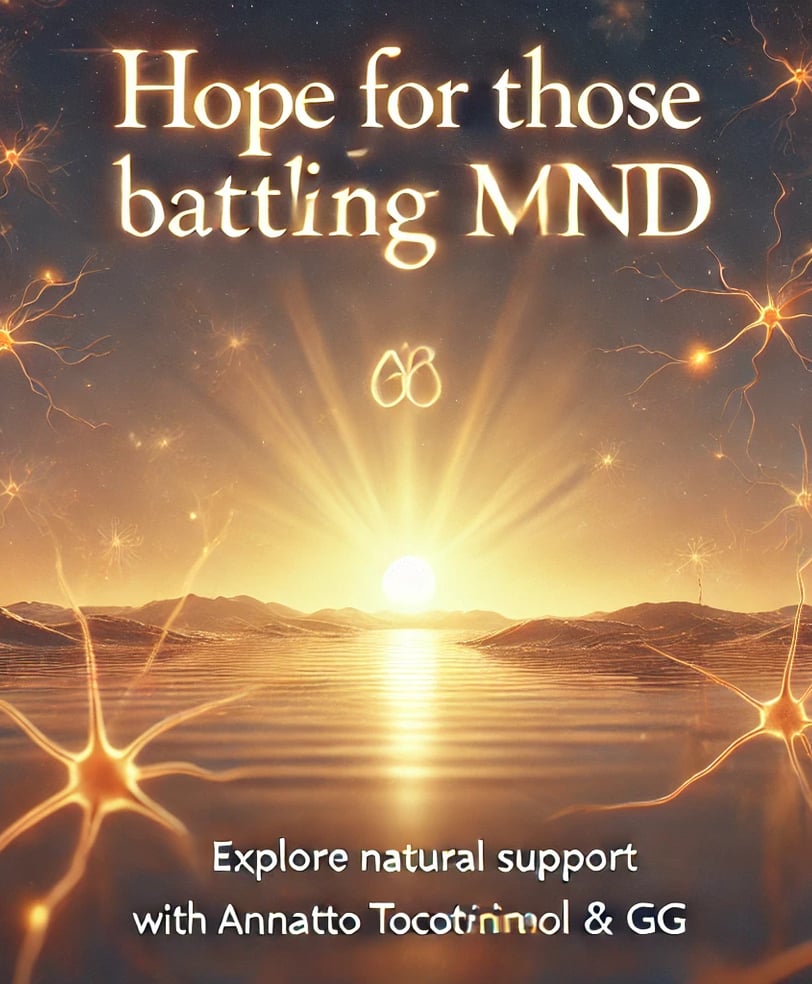AMAZING natural health products backed by research
Natural Compounds for Motor Neurone Disease Support
Explore innovative treatments for motor neurone disease (MND) with natural compounds like annatto tocotrienol and geranylgeraniol. Discover their potential benefits for neurological health and find support for those affected by this challenging condition.
ANTI-AGEINGMETABOLIC HEALTHBRAIN HEALTHINFLAMMATIONCELLULAR HEALTH
AlexanderJ
1/25/20253 min read


Why Consider Annatto Tocotrienol and GG?
1. Annatto Tocotrienol: The ‘Other’ Vitamin E
Tocotrienols are a lesser-known form of Vitamin E with unique properties that set them apart from the more common tocopherols. Derived from the annatto plant, DeltaGold® Tocotrienol is a highly potent antioxidant with benefits that extend beyond typical Vitamin E functions. It is TGA-approved in Australia (ARTG 373033), ensuring its quality and safety.
Key benefits of tocotrienol include:
Oxidative Stress Relief: MND is closely linked to oxidative stress, which damages motor neurons. Tocotrienols’ powerful antioxidant properties help protect neurons by neutralizing harmful free radicals.
Anti-inflammatory Properties: Chronic inflammation plays a significant role in MND progression. Tocotrienols have demonstrated potent anti-inflammatory effects, offering potential relief.
Mitochondrial Protection: Tocotrienols target mitochondria, the powerhouse of cells, helping to maintain energy production and cellular health.
2. Annatto GG: Supporting Cellular Energy and Growth
Geranylgeraniol (GG) is a molecule crucial for the body’s natural energy production and protein synthesis. As we age or face illness, GG levels decline, contributing to cellular dysfunction. Supplementing with Annatto GG can:
Support Mitochondrial Function: GG aids in the production of Coenzyme Q10, essential for cellular energy.
Promote Neurological Health: By supporting the synthesis of key proteins and cellular components, GG may help maintain nerve function.
Suggested Regimen for MND Support
Annatto Tocotrienol (300mg): Take one capsule with breakfast and another with dinner.
Annatto GG (150mg): Take one capsule with lunch.
For maximum bioavailability, always take these supplements with meals. Importantly, these supplements have no serious side effects reported, and some users even notice gradual weight loss as a positive outcome over time.
The Case for Trying
These compounds offer a natural, research-supported option to complement traditional treatments for MND. While they may not be a cure, their mechanisms suggest they can help mitigate some of the challenges associated with the disease by protecting neurons, reducing inflammation, and supporting cellular health.
A Word of Caution
It is vital to consult your healthcare professional before starting any new supplement regimen. Annatto Tocotrienol and GG should be used as complementary support alongside your medical treatment plan.
Join the Fight Against MND
If you or a loved one is living with MND, exploring these natural compounds could be a step toward hope. What do you have to lose by trying? Visit our website at:
https://naturalhealthconnect.com.au or contact us at aj@naturalhealthconnect.com.au for more information.
Together, we can strive for better outcomes and brighter futures for those affected by this devastating disease.
Let’s fight MND together. Every step toward hope is a step worth taking.
References
Below are several studies that explore the potential benefits of Annatto Tocotrienol and Geranylgeraniol (GG) in the context of neurodegenerative diseases and related health concerns:
1. Tocotrienols and Neurodegenerative Disorders
A comprehensive review titled "An Interactive Review on the Role of Tocotrienols in Neurodegenerative Disorders" discusses the beneficial effects of tocotrienols on neurodegenerative diseases, including Alzheimer's and Parkinson's. The review highlights that tocotrienols exhibit neuroprotective properties through antioxidant and anti-inflammatory mechanisms. However, it also notes the absence of clinical trials confirming efficacy in human subjects, indicating a need for further research.
2. Geranylgeraniol Supplementation in Human Subjects
A pilot study titled "Geranylgeraniol Supplementation Leads to an Improvement in Hyper-IgD Syndrome" evaluated the safety and efficacy of dietary geranylgeraniol supplementation in three patients. Over three months, GG supplementation showed no liver toxicity and did not alter lipid profiles, suggesting its safety in human consumption. While this study did not focus on neurodegenerative diseases, it provides preliminary evidence supporting the safe use of GG in humans.
3. Tocotrienols' Protective Effects in Neurodegeneration
Research titled "Tocotrienols Ameliorate Neurodegeneration and Motor Deficits in Animal Models" indicates that tocotrienols can prevent neurodegeneration or halt disease progression by targeting activated neuroglia and regulating proinflammatory cytokines. These findings suggest potential therapeutic roles for tocotrienols in neurodegenerative diseases.
4. Biological Properties of Tocotrienols in Human Studies
The article "Biological Properties of Tocotrienols: Evidence in Human Studies" discusses advancements showing tocotrienols' protective effects against neurodegeneration, among other conditions. This evidence underscores the potential of tocotrienols in supporting neurological health.
5. Safety of Annatto-Derived Tocotrienol Supplementation
A study titled "A 12-Week Evaluation of Annatto Tocotrienol Supplementation for Postmenopausal Women" found that annatto-derived tocotrienol up to 600 mg per day for 12 weeks appeared to be safe, particularly concerning liver and kidney functions. This supports the safety profile of tocotrienol supplementation in humans.
BMC Complementary Medicine and Therapies
While direct clinical evidence of Annatto Tocotrienol and GG's efficacy in treating neurodegenerative diseases like MND is currently limited, these studies provide a foundation for their potential benefits and safety in humans. Further clinical trials are necessary to establish definitive therapeutic roles for these compounds in neurodegenerative conditions.
